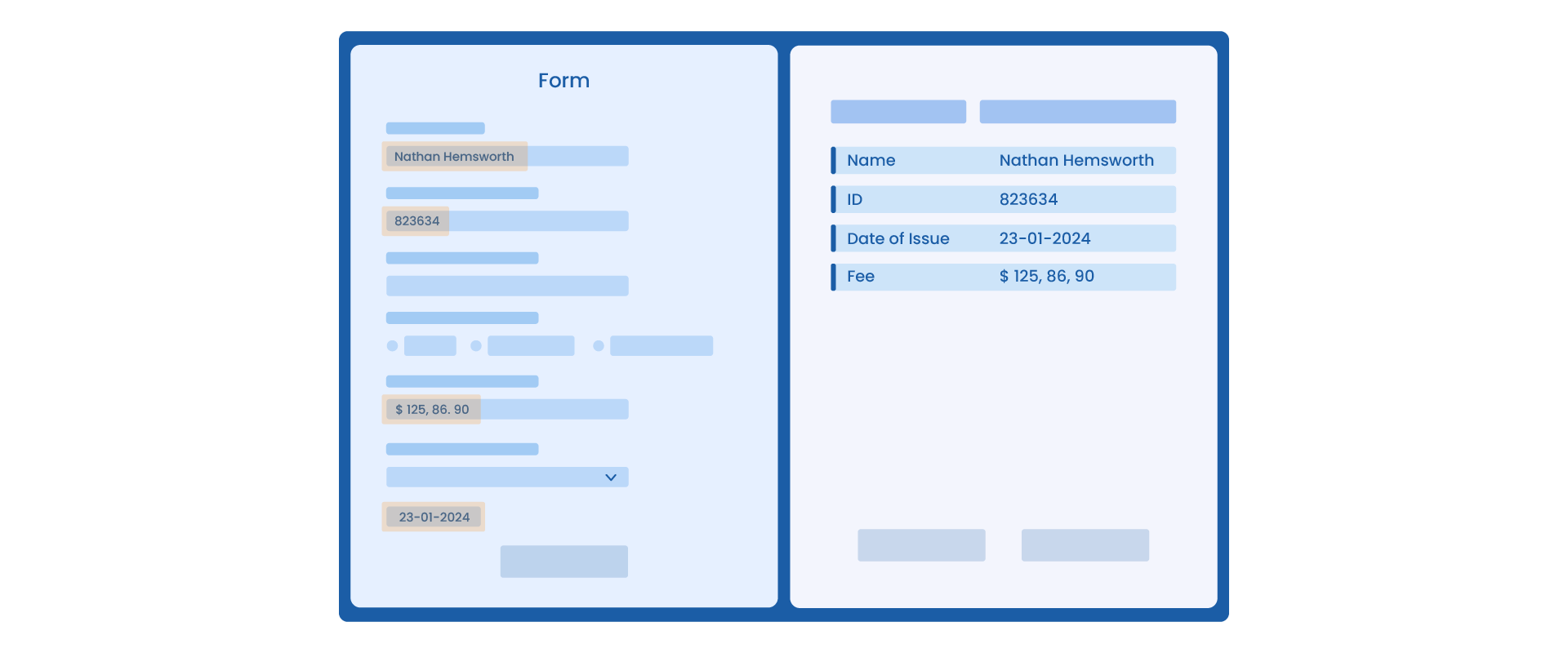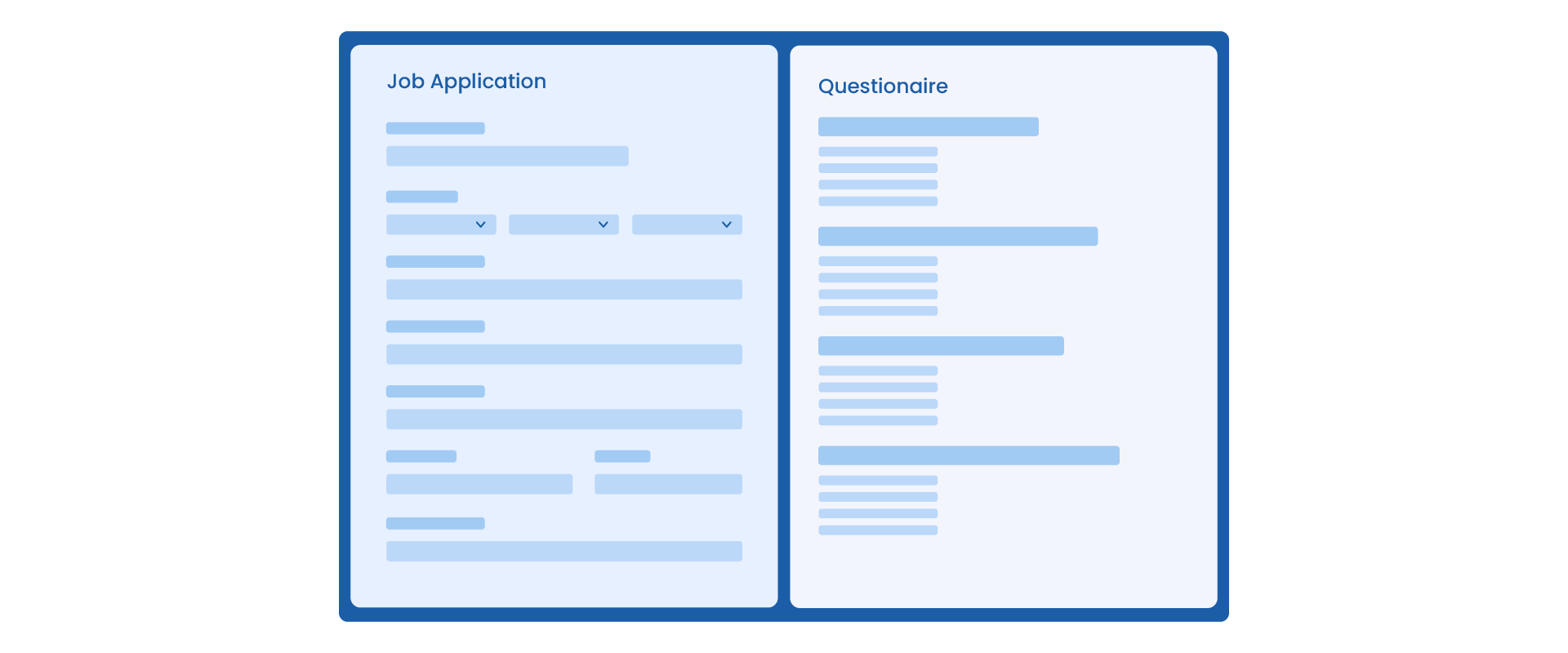
Your Complete Guide to Form Processing
The global data extraction market is predicted to reach a value of $4.90 billion by 2027, boasting a significant CAGR of 11.8%. This growth is largely due to the crucial role played by Form Processing, a technology that has emerged as a fundamental element in the efficient extraction and processing of valuable insights from both structured and unstructured data.
What is Form Processing?
Form processing refers to the systematic method of extracting, organizing, and storing data from completed forms. It’s an essential process for businesses and organizations, allowing them to collect valuable information and make informed decisions.

Companies receive hundreds or even thousands of forms daily. Without a streamlined process in place, handling this influx of data can lead to errors, delays, and inefficiencies. Form processing eliminates these problems by automating the data extraction and storage, ensuring quick and accurate results.
Key Components of Form Processing
Form processing consists of three major components:
1. Data Capture:
This process captures data entered on forms, including text, numbers, and dates.
Data capture is a critical step in form processing as it ensures that all the relevant information provided by the form filler is accurately recorded. This process can be achieved through various methods, such as manually extracting data or using optical character recognition (OCR) to extract text from scanned forms. Form processing enables businesses to gather comprehensive and diverse information by capturing a wide range of data types.
2. Data Entry:
Data entry writes the captured data into a structured destination, such as a database or an Excel file, that can be easily accessed and analyzed. Data entry operators can perform this process manually, or the process can also be automated using software tools. Manual data entry requires careful attention to detail to ensure accuracy, while automated data entry can significantly reduce the time and effort required. Regardless of the method used, data entry lays the foundation for subsequent data analysis and decision-making.
3. Data Validation:
This step ensures that the entered data is accurate, complete, and within specified parameters. It helps identify errors or missing information, minimizing the chances of inaccuracies in data.
Data validation ensures the integrity and reliability of the collected data. This process involves performing checks on the entered data to verify its accuracy and consistency. For example, a user can validate a phone number field to ensure it follows the correct format or check the range of values entered in a numerical field. By validating the data, businesses can identify and correct errors or inconsistencies, ensuring that the information is reliable and trustworthy.
Diverse Applications of Form Processing in Various Industries
Form processing is used in a variety of different scenarios across different industries. Some common examples include:
- Online Registration Forms: Educational institutions, conferences, and events often use online registration forms to collect participant information. Form processing can automate data extraction like names, addresses, and contact details.
- Job Application Forms: Companies receive numerous job applications with standardized forms. Form processing can automate the extraction of candidate details such as education history, work experience, and skills from these applications.
- Insurance Claims: Insurance companies deal with a large volume of claim forms. Form processing can extract relevant information like policy details, incident descriptions, and supporting documentation, streamlining the claims processing workflow.
- Surveys and Feedback Forms: Businesses and research organizations often use surveys and feedback forms to gather opinions and insights. Form processing can extract and analyze responses, making it easier to understand trends and patterns.
- Bank Loan Applications: Banks and financial institutions receive loan applications with standardized forms. Form processing can automate the extraction of financial details, employment history, and other relevant information for quick and accurate evaluation.
- Healthcare Forms: Patient intake forms, medical history forms, and insurance claims in healthcare involve a lot of unstructured data. Form processing extracts patient details, medical history, and insurance information to improve the efficiency of healthcare processes.
- Tax Forms: Government agencies and tax authorities process large volumes of tax forms to extract income details, deductions, and other relevant information to ensure accurate tax assessment.
Manual vs. Automated Form Processing
There are two main types of form processing: manual form processing and automated form processing.
Manual Form Processing
Traditionally, form processing was done manually, with employees reading and transcribing data from forms into tabular formats. This process was time-consuming, prone to errors, and lacked scalability. However, manual form processing remains applicable in specific scenarios, such as when processing handwritten or complex forms that demand human judgment. Complex forms involving subjective decision-making or human expertise may also require manual processing.
Automated Form Processing
Automated form processing, on the other hand, involves leveraging technology to extract data from electronic forms automatically. This approach has become popular due to its efficiency, accuracy, and scalability.
Automated form processing offers several advantages over manual processing. For starters, it eliminates the need for human intervention in routine form processing, freeing up valuable time and resources. Also, it minimizes the chances of errors that can occur during manual data entry, ensuring data integrity. In addition, automated form processing allows for seamless integration with existing systems, enabling efficient data management.
Businesses can customize automated form processing to suit their specific needs. For instance, they can program it to extract specific data fields, validate the information, and perform various data manipulation tasks. This level of automation saves time and enhances data accuracy and consistency. Although, forms with complex layouts, non-standard formats, or unusual data structures may require additional customization or human intervention to ensure accurate data extraction.
Comparison Table: Manual vs Automated Form Processing
| Criteria | Manual Form Processing | Automated Form Processing |
| Speed | Slow, as it relies on human data entry. | Faster, as it utilizes automated tools and algorithms. |
| Accuracy | Prone to errors due to human mistakes. | More accurate, with reduced chances of human error. |
| Cost | Expensive due to labor costs. | Initial setup costs are higher, but ongoing operational costs are lower. |
| Efficiency | Less efficient as it depends on human speed and availability. | More efficient, providing quick and consistent results. |
| Scalability | Limited scalability due to reliance on human resources. | Highly scalable, able to process large volumes of forms with ease. |
| Flexibility | Limited flexibility, especially for handling complex forms. | More flexible, with the ability to adapt to various form structures. |
| Data Validation | Relies on manual validation, which may lead to oversight. | Automated validation ensures data accuracy and compliance. |
| Integration with Systems | May require manual data entry into other systems. | Can be seamlessly integrated with other systems for data transfer. |
| Security | Potential security risks due to manual handling of sensitive information. | Can be more secure with encryption and access controls in place. |
| Human Resources | Requires a significant workforce for data entry and validation. | Requires minimal human intervention, allowing employees to focus on higher-value tasks. |
| Error Handling | Relies on human detection and correction of errors. | Automated error detection and handling can be built into the system. |
What Makes Form Processing Challenging?
- Variability in Formats: Forms come in various formats and layouts. They can be in a tabular or narrative layout. The fields may be organized differently, and the structure of the form can vary.

- Inconsistent Data Quality: Forms may have missing or incomplete information, illegible text in case of scanned forms, or errors. Ensuring data accuracy and completeness becomes a challenge when dealing with inconsistent data quality.

- Sensitive Information Handling: Many forms contain sensitive or personally identifiable information. Ensuring the security and privacy of the data during the processing stage is a significant challenge.
- Scalability: Handling large volumes of forms efficiently and in a timely manner is crucial for many applications. Ensuring that the form processing system can scale to meet increasing demands is a significant challenge.
The Evolution of Form Processing Solutions
As technology continues to advance, the integration of AI and machine learning in form processing has become more prevalent. These technologies enable intelligent form recognition, automated data extraction, and advanced data analysis.
Advanced optical character recognition (OCR) technology is one of the prominent technologies, allowing these form-processing systems to accurately extract data from scanned documents. The integration of AI extends beyond OCR, providing the capability to understand and process unstructured data within forms automatically.
Real-time data extraction and AI’s adaptability to handle complex forms mark the forefront of contemporary form processing solutions. The emphasis on AI not only enhances accuracy and efficiency but also aligns with broader industry trends, contributing to the ongoing digital transformation by reducing manual labor and optimizing workflow processes.
Astera for All Your Form Processing Needs
Astera, equipped with cutting-edge AI technology, stands out as a powerful solution for all your form processing needs, delivering a specialized toolkit tailored to extract meaningful data seamlessly from various form types. Whether dealing with customer surveys, application forms, or compliance documents, Astera excels in transforming unstructured form data into organized, usable information through advanced AI algorithms.
Its intuitive interface simplifies extraction, allowing users to capture and validate data fields effortlessly. With support for diverse form formats, including PDFs and scanned documents, Astera ensures adaptability to different layouts. Beyond extraction, the solution also offers robust data cleansing and validation features, ensuring the accuracy and reliability of the processed information.
For organizations seeking an efficient, user-friendly tool, Astera is the answer. Experience its power with a 14-day free trial and a personalized demo with our experts—unlock the potential of AI-driven form processing today!
 Astera AI Agent Builder - First Look Coming Soon!
Astera AI Agent Builder - First Look Coming Soon!

